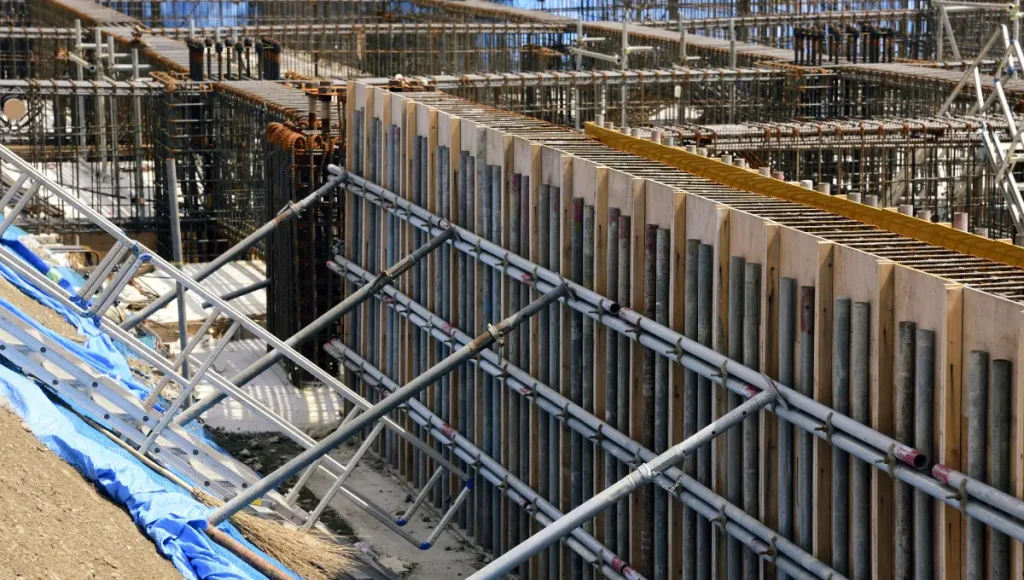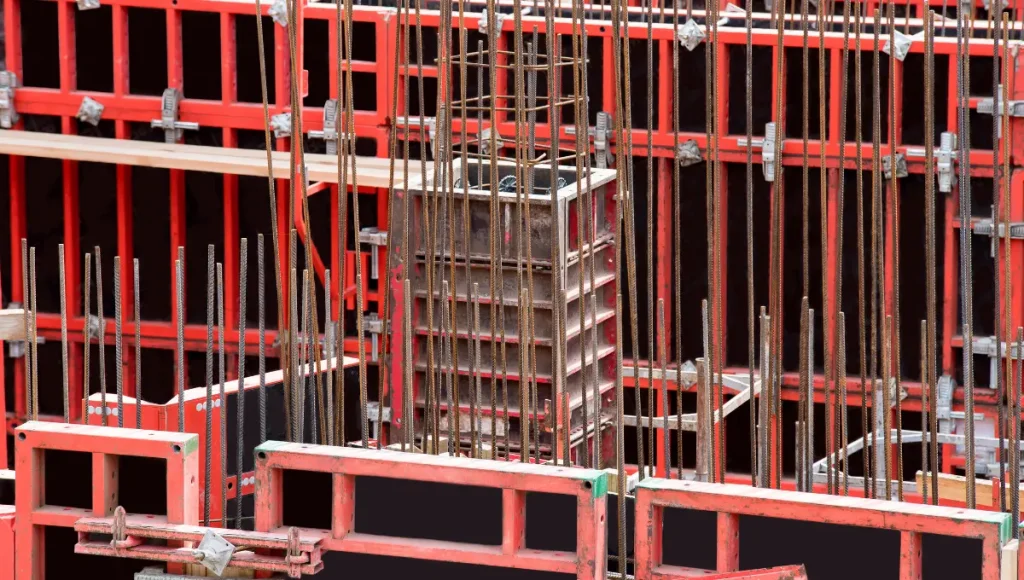What is shuttering?
Shuttering or formwork is the temporary or permanent mold used in construction to support the shape of concrete until hardening and award of strength. This becomes very imperative while constructing concrete-based structures like walls, slabs, columns, beams, among others.etc.
Proper shuttering is undertaken so that the correct shape and dimensions are obtained after the pouring of concrete. This would provide a stable framework during the curing process.

Why is Shuttering important in Construction?
Construction without shuttering would be like baking a cake without a mold.
It is necessary to shape concrete into desired structural forms such as walls, slabs, columns and beams.This ensures that the concrete sets in correct shape and dimension which reduces the collapse and messy outcome.
Until the wet concrete hardens and has sufficient strength to bear its weight and any additional loads, shuttering supports and ensures the concrete is held in place.
Types of Shuttering In Construction
Different types of shuttering materials and methods are used based on project’s requirements which has unique benefits and challenges. Having a fair knowledge about the types are crucial for selecting the most appropriate formwork for efficient, cost-effective and hig-quality construction.
1. Steel Shuttering:
The core material used here is Steel.
This makes it very appropriate for high-rise building, bridge, and major infrastructure constructions due to the strength and reusability of the formwork.
Shuttering made with steel is highly durable, reusable, and gives a smooth finish than other types of shuttering which is ideal for large projects and repetitive uses.
2. Timber Shuttering:
It is more of wood which is suitable for residential buildings, small commercial projects and where customized shapes are required.
Easy to assemble, remove and can be cut to any size or shape for small projects.
When compared to steel, it is less durable and reusable but prone to warping and damage from moisture.
3. Plywood Shuttering:
In this type of shuttering, plywood sheets are often used.
When combined with timber or steel, it provides a smooth finish for slabs, beams, and columns in both residential and commercial buildings.
Though plywood shuttering is lightweight and easy to handle, it is less durable than steel and can be susceptible to water damage if not properly treated.
4. Plastic Shuttering:
Plastic shuttering is ideal for repetitive uses in housing projects, water tank and temporary structures.
Lightweight, easy to handle, and reusable.
However, it’s not as strong as steel, not economical for huge projects. It’s a bit more expensive on the front end.
5. Tunnel Shuttering:
Tunnel Shuttering involves Steel and Aluminium which can be applied in construction of tunnels, subways, drainage system, and underpasses. I.e, Wherever repetitive shapes are essential, this type of shuttering is considered.
Though it is expensive and specialized, it provides a continuous formwork system for constructing tunnels, culverts, and similar structures.
This requires precise engineering and skilled labor when compared to other types of construction.
6. Wall Shuttering:
Building a wall should be taken much care as it is initial phase where construction evolves.
In general, for vertical concrete structures in both residential and commercial building this type of shuttering is used.
It involves steel, timber, or plywood,providing strong and stable support for vertical structures.
Depending on the material, it can be heavy and may require skilled labor for installation.
7. Fabric Shuttering:
Fabric formwork is used for both cast-in-place and precast concrete applications. Whether for walls, columns, slabs, foundations,or precast elements; fabric formwork enhance the quality and efficiency.
It is easy to handle and transport.
Based on the application, material type and construction, Engineers can adopt Woven Fabric shuttering where polyester or nylon involved, Non-Woven Shuttering where chemical, mechanical or thermal process involved, Geotextile fabric, Elastomeric fabric which uses polyurethane or rubber blends and lastly, Reinforced fabric Shuttering which uses additional materials like steel mesh or polymer grids.
Necessary things to consider for shuttering

When selecting and using shuttering, several factors need to be considered to ensure the success of the concrete construction project.
Here are some:
1. Materials Used:
The materials chosen for shutteirng should be strength sufficient to bear the weight and pressure that the wet concrete exerts without deforming or breaking.
Here, strong materials like steel and high-quality plywood make this possible to have formwork reused a number of times.
Being water resistant may prevent swelling, warping, or weakening when exposed to wet concrete. For this, waterproof treated timber or marine plywood, plastic, and metal are preferable.
2. Strength:
The shuttering should bear shards and pressures of wet concrete at any time without deformation or collapse.
Its good to have a check on the formwork material and its design on its capability to bear the imposed load.
For Residential Construction, the formwork should be able to support a concrete pressure of around 1.5 to 2 kN/m² for walls and around 4 kN/m² for slabs.
And for Commercial and Industrial Projects, the requirements may be higher. The formwork need to support pressures of up to 10 kN/m² or more, depending on the height and thickness of the concrete being poured.
3. Watertightness/Less Leakage:
Watertightness is a crucial factor in shuttering. This avoids the leakage of concrete mix, which leads to weak spots and defects in the final structure.
All joints between shuttering panels should be sealed with rubber gaskets, foam strips, or sealant compounds to avoid leakage.
4. Smooth Surface:
The smoothness of the shuttering impacts the quality of the concrete finish. Materials like plywood,timber, plastic or steel, provides a smooth finish and reduce the need for additional surface treatment.
To prevent the concrete from sticking and to achieve smooth finish, a release agent (formwork oil) to the shuttering surface is applied. It is recommended to ensure the formwork is clean and free from any debris, dirt, or previous concrete residue before reuse.
Techniques such as troweling, sanding, or using skim coats can enhance the final finish.
5. Simple Removal:
Shuttering should be designed for quick and easy assembly and disassembly. Modular systems that fit together with minimal effort are ideal which does not consume much time.
Proper bracing and support systems should be done where the use of quick-release mechanisms or clamps to speed up the dismantling process are considered.
6. Consistency:
The formwork is designed according to the project’s blueprints and specifications. This provides the consistent dimensions and shapes throughout the structure.
It won’t end upto planning, Conducting a thorough inspection of the formwork before pouring concrete to avoid placing uneven pressure on the shuttering, regular maintenance schedule to check and repair, and being consistent in size and shape of shuttering will never be overlooked.
7. Rigidity or Stiffness:
The formwork should be rigid and stiff to maintain its shape under the load of the concrete.
It is better to avoid materials that can bend or flex, which leads to deformations in the concrete.
8. Insulation:
Consider the thermal properties of the shuttering material, especially in cold weather conditions.
Proper insulation can help to maintain the desired temperature for the concrete to cure effectively.
9. Safety:
Ensure the shuttering is designed and installed with safety in mind.
Proper bracing and supports are necessary to prevent accidents during the concrete pouring and setting process.
Is Shuttering and Formwork the Same?
Yes, shuttering and formwork are often used interchangeably in construction. Both refer to the temporary or permanent molds used to shape and support concrete until it hardens and achieves the necessary strength.
The choice of term can depend on regional preferences or specific industry practices, but they essentially describe the same process and function in concrete construction.
FAQs
Ensure quality by planning the design, using durable materials, assembling correctly, and inspecting for gaps or misalignments before pouring concrete.
Steel shuttering is preferred for large projects because it is strong, durable, and provides a smooth finish, making it ideal for repetitive use and achieving high-quality concrete surfaces.
Yes, shuttering can be reused, especially if made from durable materials like steel, aluminum, or plastic, which can withstand multiple cycles of concrete pouring without losing shape or integrity.

